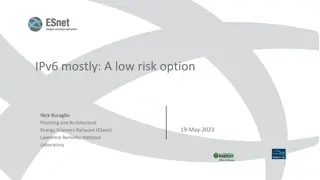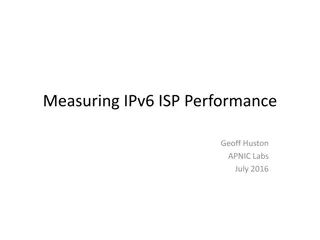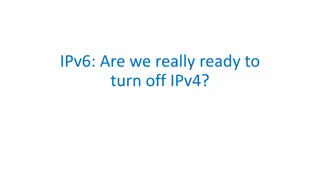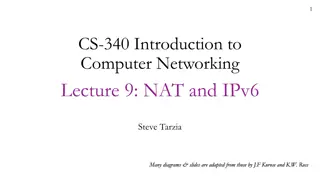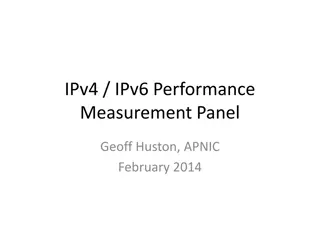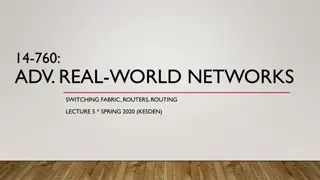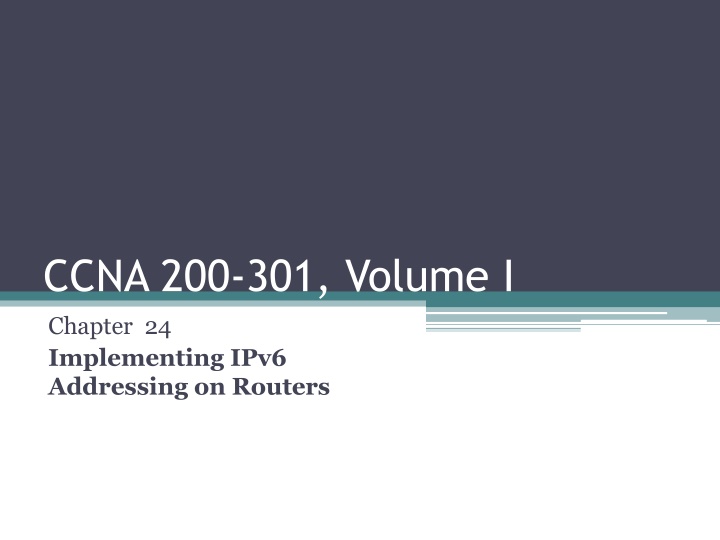
Implementing IPv6 Addressing on Routers: Practical Guide & Examples
Discover how to implement IPv6 addressing on routers, including configuring static IPv6 addresses, verifying settings, and displaying connected IPv6 routes. This comprehensive guide covers the migration of enterprise networks to IPv6, special addresses used by routers, and the format of IPv6 addresses with interface IDs and EUI-64. Get insights into the likely path through dual-stack IPv4 and IPv6 over an extended period. Visual aids and step-by-step instructions included.
Download Presentation

Please find below an Image/Link to download the presentation.
The content on the website is provided AS IS for your information and personal use only. It may not be sold, licensed, or shared on other websites without obtaining consent from the author. If you encounter any issues during the download, it is possible that the publisher has removed the file from their server.
You are allowed to download the files provided on this website for personal or commercial use, subject to the condition that they are used lawfully. All files are the property of their respective owners.
The content on the website is provided AS IS for your information and personal use only. It may not be sold, licensed, or shared on other websites without obtaining consent from the author.
E N D
Presentation Transcript
CCNA 200-301, Volume I Chapter 24 Implementing IPv6 Addressing on Routers
Objectives Implementing Unicast IPv6 Addresses on Routers Special Addresses Used by Routers
Migration of Enterprise Networks to use TCP/IP Stack Only, IPv4
Likely Path Through Dual-Stack (IPv4 and IPv6) over a Long Period
128-bit IPv6 Addresses to be Configured on Cisco Router Interfaces
Verifying Static IPv6 Addresses on Router R1 (Continued) R1#show ipv6 interface S0/0/0 Serial0/0/0 is up, line protocol is up IPv6 is enabled, link-local address is FE80::1FF:FE01:101 No Virtual link-local address(es): Description: link to R2 Global unicast address(es): 2001:DB8:1111:2::1, subnet is 2001:DB8:1111:2::/64 Joined group address(es): FF02::1 FF02::2 FF02::A FF02::1:FF00:1 FF02::1:FF01:101 MTU is 1500 bytes ! Lines omitted for brevity R1#show ipv6 interface brief GigabitEthernet0/0 [up/up] FE80::1FF:FE01:101 2001:DB8:1111:1::1 GigabitEthernet0/1 [administratively down/down] unassigned Serial0/0/0 [up/up] FE80::1FF:FE01:101 2001:DB8:1111:2::1 Serial0/0/1 [administratively down/down] unassigned
Displaying Connected IPv6 Routes on Router R1
IPv6 Address Format with Interface ID and EUI-64
Two Examples of Most of the EUI-64 Interface ID Process
Inverting the 7th Bit of an EUI-64 Interface ID Field
A Mnemonic Device to Help Memorize Hex Digits before and after 3rd Bit Inversion
IPv6 EUI-64 Address Creation Practice Prefix MAC Address Unabbreviated IPv6 Address 2001:DB8:1:1::/64 0013.ABAB.1001 2001:DB8:1:1::/64 AA13.ABAB.1001 2001:DB8:1:1::/64 000C.BEEF.CAFE 2001:DB8:1:1::/64 B80C.BEEF.CAFE 2001:DB8:FE:FE::/64 0C0C.ABAC.CABA 2001:DB8:FE:FE::/64 0A0C.ABAC.CABA
Router Configuration to Learn IPv6 Addresses with DHCP And SLAAC
IPv6 Using Link-local Addresses as the Next-Hop Address
Comparing Link-local Addresses with EUI-generated Unicast Addresses
Key IPv6 Local-Scope Multicast Addresses
Verifying Static IPv6 Addresses on Router R1
Verifying Static IPv6 Addresses on Router R1
Configuring and Verifying IPv6 Anycast Addresses
Summary of IPv6 Address Types and the Commands That Create Them Type Prefix/Address





